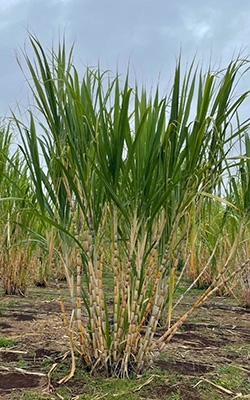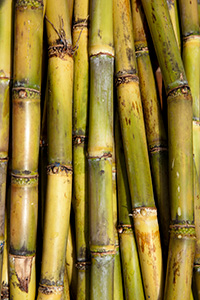Sugarcane

With foodscapes increasing in popularity, one way you can add an attractive edible to your landscape is by planting sugarcane. This perennial grass from the genus Saccharum ranges in color from green to red to purple. There are different varieties for various intended uses; some are bred for chewing, while others are grown for crystalizing, or for making syrup.
Characteristics
Sugarcanes bred for chewing tend to be softer, with fibers that stick together when chewed, to make releasing the sweet juice easier. Crystal canes, which are typically commercial varieties, have a higher sucrose concentration that is ideal for producing granulated sugar. Syrup canes have less sucrose than crystal canes, but they have other types of sugar molecules that are less likely to crystalize during the syrup-making process. Most gardeners choose either a chewing or syrup cane, depending on their post-harvest plans.
Planting and Care
Sugarcane is only grown from stalk cuttings, called “seed-cane,” because it will not breed true from seeds. To vegetatively propagate sugarcane, cut mature cane stalks into smaller sections containing five to six “buds.” Each bud is a growing point, and these are located at the nodes along the canes. Five to six buds may seem excessive, but it’s important to have several in case a few of the buds fail to germinate. The buds (future shoots) on two adjacent nodes are on opposite sides of the cane stalk, but don’t worry about bud orientation during stalk planting. Emerging shoots will still find their way to the soil surface even if buds are pointing downward.

Try finding seed-cane at your local farmers market or from online sources. Seed-canes can also be acquired from other gardeners in the community who have the variety you’re looking for. The experts at your county Extension office can help you find sources of seed-canes nearby. The seed-cane will produce a plant that is a genetically identical clone of the original, so pay attention to the characteristics of the parent plant to know how yours will develop.
Once seed-canes are cut, they should be stored in a cool, moist place for up to two weeks. Dipping the ends of the pieces in hot paraffin will help them stay moist for longer periods, if necessary. Sugarcane should either be planted before a killing frost, or after the onset of winter. The first option means the planted seed-pieces will have already germinated (showing both shoot and root growth), which will help the cane overcome the stress of winter. The second option encourages the planted seed pieces to enter a dormant state through winter, followed by sprouting in the spring.
Sugarcane works well as an intercrop with vegetables and/or nitrogen-fixing legumes. These other crops will mature and be harvested before the sugarcane grows large enough to shade them. Sugarcane can also serve as a natural windbreak in the garden.
Don’t plant sugarcane along highly trafficked areas or pathways because the sharp-edged leaves can hurt people. Some varieties are also prone to falling over or “lodging” when mature, which can block walkways. Plant sugarcane in a sunny location with good drainage, although the plant can withstand some flooding once mature. Thoroughly till the soil in and around the planting location so the sugarcane can easily grow its root system.

Sugarcane can be planted in a single row or in multiple parallel rows that are four to ten feet apart. Dig a furrow six inches deep (slightly deeper in sand or highly organic soils), and then apply fertilizer. One pound of 8-2-8 fertilizer every 10 feet is typically fine, but the best way to know your fertilizer needs is to test your soil. Contact your county Extension office for assistance with soil testing and fertilizer recommendations. Next, sprinkle one to two inches of soil over the fertilizer and lay the seed-cane pieces lengthwise on top. Instead of placing the pieces end to end, allow them to overlap. The end of one piece should reach to the middle of the next piece to promote even spacing since all buds may not produce shoots. Then, cover the canes with four to six inches of soil.
Keep the soil moist, but don’t drown your new plants. New shoots should emerge within one to three weeks unless low temperatures cause dormancy. Once you have shoots, continually build up your furrows by adding soil to encourage shoot growth. You can do this as you hoe or till around the plants for weed management. If you planted in the winter, keep in mind that newly emerging leaves will be susceptible to frost damage. However, it is unlikely that the plant will sustain serious damage unless the meristem (growing point) is no longer protected underground.

The primary shoot will form buds at each underground stalk joint, and secondary shoots will sprout from these buds. As your sugarcane grows, you may need supplemental fertilizer applications to encourage production. Be sure to halt fertilizer application after mid-July because late application can delay maturity and reduce sugar content.
Manual weeding and mulching to prevent weeds is preferred over chemical methods, and will likely suffice. Sugarcane is bred to resist disease, but you can also prevent the spread of disease by disinfecting gardening tools and harvesting equipment. Plants are typically resistant to pests due to their rapid growth and the help of natural predators, parasites, and seasonal conditions. You should still enjoy a plentiful harvest even if the plant is attacked by common pests like wireworms, grubs, stalk borers, mealy bugs, termites, or aphids. Prevent damage from rodents and rabbits by implementing physical barriers.
Given the earlier planting instructions, your sugarcane will be ready for harvest by early November the following year. Use a sharp knife or lopping shears to cut the mature stalks near the soil surface. Make sure to do this before a killing freeze because the tender regrowth from the freshly cut sugarcane stalks will be susceptible to the cold. Trim the green, upper portion of the stalk that lacks sugar. Then, either crush the stalks for juice or cut them into pieces for chewing.
Vigorous regrowth will occur in the spring as the soil begins to warm up. Once you see signs of regrowth, apply the same amount of fertilizer that you applied at planting by sprinkling it over the plant. Sugarcane will continue to produce for many years, although you should replant every five to ten years to ensure a plentiful harvest.
For more information on growing sugarcane in your area, contact your county Extension office.
